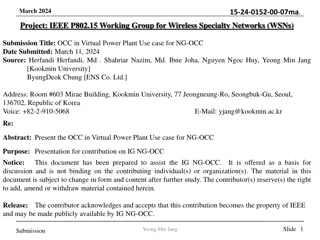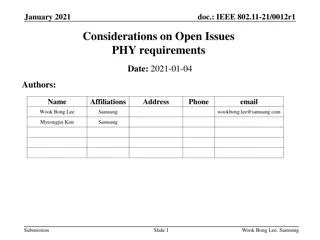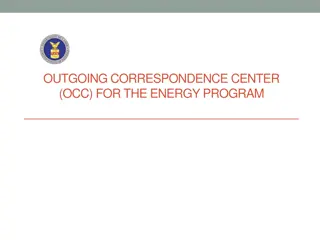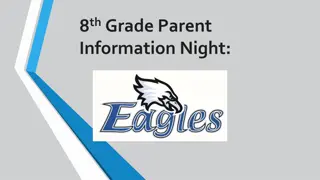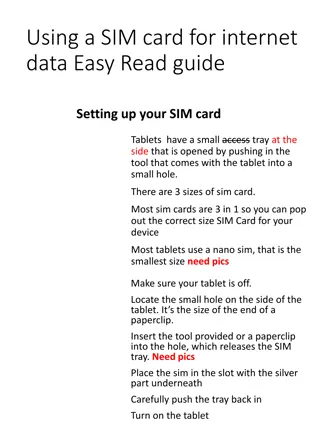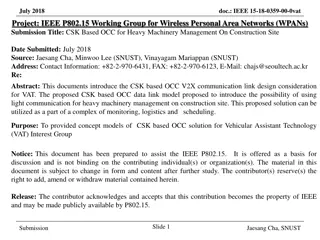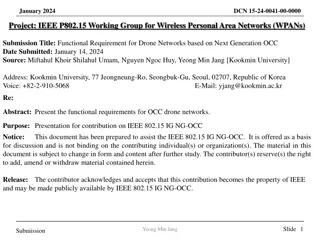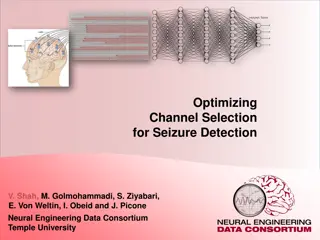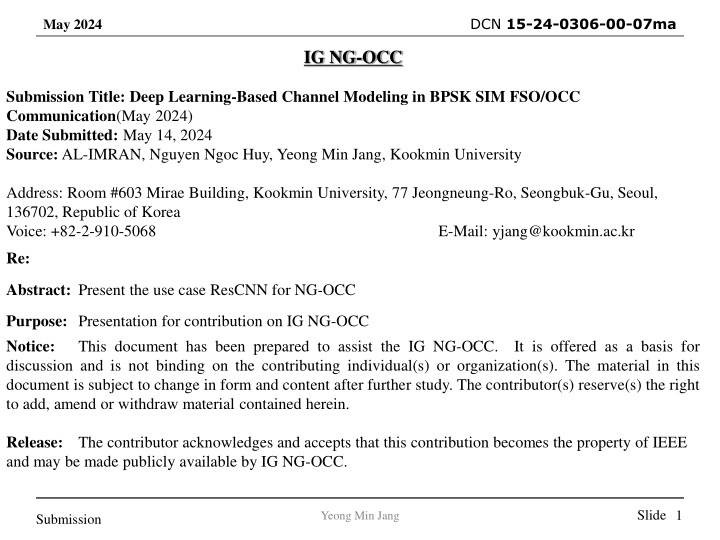
Deep Learning-Based Channel Modeling in FSO/OCC Communication
Explore the use of deep learning for channel modeling in BPSK-IM FSO/OCC communication. Understand the fundamentals of free space optical communication, channel modeling, and the impact of weather conditions. Discover machine learning techniques for channel estimation and references for further study.
Download Presentation

Please find below an Image/Link to download the presentation.
The content on the website is provided AS IS for your information and personal use only. It may not be sold, licensed, or shared on other websites without obtaining consent from the author. If you encounter any issues during the download, it is possible that the publisher has removed the file from their server.
You are allowed to download the files provided on this website for personal or commercial use, subject to the condition that they are used lawfully. All files are the property of their respective owners.
The content on the website is provided AS IS for your information and personal use only. It may not be sold, licensed, or shared on other websites without obtaining consent from the author.
E N D
Presentation Transcript
DCN 15-24-0306-00-07ma May 2024 IG NG-OCC Submission Title:Deep Learning-Based Channel Modeling in BPSK SIM FSO/OCC Communication(May 2024) Date Submitted: May 14, 2024 Source: AL-IMRAN, Nguyen Ngoc Huy, Yeong Min Jang, Kookmin University Address: Room #603 Mirae Building, Kookmin University, 77 Jeongneung-Ro, Seongbuk-Gu, Seoul, 136702, Republic of Korea Voice: +82-2-910-5068 E-Mail: yjang@kookmin.ac.kr Re: Abstract: Present the use case ResCNN for NG-OCC Purpose: Presentation for contribution on IG NG-OCC Notice: This document has been prepared to assist the IG NG-OCC. It is offered as a basis for discussion and is not binding on the contributing individual(s) or organization(s). The material in this document is subject to change in form and content after further study. The contributor(s) reserve(s) the right to add, amend or withdraw material contained herein. Release: The contributor acknowledges and accepts that this contribution becomes the property of IEEE and may be made publicly available by IG NG-OCC. Slide 1 Yeong Min Jang Submission
DCN 15-24-0306-00-07ma May 2024 Deep Learning-Based Channel Modeling in BPSK SIM FSO/OCC Communication May 14, 2024 Slide 2 Yeong Min Jang Submission
DCN 15-24-0306-00-07ma May 2024 Contents Introduction Free Space Optical Communication Channel Modeling Result and Discussion Slide 3 Yeong Min Jang Submission
DCN 15-24-0306-00-07ma May 2024 Introduction Free Space Optical (FSO) communication is a wireless communication technology that uses light to transmit data through free space, typically in the form of laser beams. It operates by sending modulated light signals through the atmosphere, with the receiver detecting and interpreting these signals. FSO offers high bandwidth and security, but its performance can be affected by weather conditions such as fog, rain, or snow. Channel modeling is a fundamental aspect of wireless communication system design. It refers to the process of creating mathematical or statistical models to simulate the behavior and characteristics of a communication channel. Slide 4 Yeong Min Jang Submission
DCN 15-24-0306-00-07ma May 2024 Channel Estimation Machine Learning Based Channel Estimation Conventional Channel Estimation Deep learning based (3) Least Square Estimation (LS)(1) Conventional Neural Network based (4) Least Minimum Mean Squared Error (LMMSE)(2) Deep Residual Learning (5) FFDNet-based (6) Maximum Likelihood Estimation (ML) ResCBDNet References 1.Y. S. Hussein, M. Y. Alias, and A. A. Abdulkafi, On performance analysis of LS and MMSE for channel estimation in VLC systems, in Proc. IEEE 12th Int. Colloq. Signal Process. Appl. (CSPA), Melaka, Malaysia, 2016, pp. 204 209. 2.X. Shi, S.-H. Leung, and J. Min, Adaptive least squares channel estimation for visible light communications based on tap detection, Opt. Commun., vol. 467, Jul. 2020, Art. no. 125712 3. C.-J. Chun, J.-M. Kang, and I.-M. Kim, Deep learning-based channel estimation for massive MIMO systems, IEEE Commun. Lett., vol. 8, no. 4, pp. 1228 1231, Aug. 2019. 4. G. Fan, J. Sun, G. Gui, H. Gacanin, B. Adebisi, and T. Ohtsuki, Fully convolutional neural network-based CSI limited feedback for FDD massive MIMO systems, IEEE Trans. Cogn. Commun. Netw., vol. 8, no. 2, pp. 672 682, Jun. 2022 5. C. Liu, X. Liu, D. W. K. Ng, and J. Yuan, Deep residual learning for channel estimation in intelligent reflecting surface-assisted multiuser communications, IEEE Trans. Wireless Commun., vol. 21, no. 2, pp. 898 912, Feb. 2022. 6.Z. Gao, Y. Wang, X. Liu, F. Zhou, and K.-K. Wong, FFDNet-based channel estimation for massive MIMO visible light communication systems, IEEE Wireless Commun. Lett., vol. 9, no. 3, pp. 340 343, Mar. 2020. . Slide 5 Yeong Min Jang Submission
DCN 15-24-0306-00-07ma May 2024 Channel Modeling Difference between conventional and machine learning base channel estimation a. Using ML for channel estimation can offer advantages in scenarios where traditional methods may struggle to adapt to changing and complex channel conditions like (atmospheric turbulence or mobility of optical sources). DRL algorithms have the capability to learn and adapt to non-linear and non-stationary channel conditions, which may be difficult for traditional estimation techniques such as Least Squares Estimation, Maximum Likelihood Estimation (MLE) that assume linearity and stationarity. b. c. Traditional estimation methods may assume Gaussian noise(electronic and thermal noise). which may not accurately represent real-world noise characteristics in FSO/OCC systems. ML can learn to handle non-Gaussian noise distributions(Atmospheric turbulence). d. Traditional methods often rely on assumptions about the channel, noise, or environmental conditions. ML, being a model-free approach, can learn directly from data without making strong assumptions. Slide 6 Yeong Min Jang Submission
DCN 15-24-0306-00-07ma May 2024 Existing BPSK SIM FSO System Slide 7 Yeong Min Jang Submission
DCN 15-24-0306-00-07ma May 2024 Proposed Model The source data d(t) modulated with carrier signal. The modulated signal, denoted by x(t), is transmitted by an FSO transmitter across an atmospheric turbulence channel, where it encounters thermal, background and quantum noise at the FSO receiver with zero mean and a variance. ?? d(t) x(t) Drive Circuit B-PSK SIM-Modulation ?0 DC bias Weak Moderate Strong Turbulent FSO Link The signal received at the receiver is fed into our model.We train the model using noisy received signal and corresponding transmitted signal with various levels of noise and fading before testing.The training goal is to minimize the difference between the output of the ResCNN and the desired or transmitted signal. d(t) y(t) Photo- Diode Residual CNN De- modulation n(t) Noise Slide 8 Yeong Min Jang Submission
DCN 15-24-0306-00-07ma May 2024 Simulation Parameter Slide 9 Yeong Min Jang Submission
DCN 15-24-0306-00-07ma May 2024 Results and Discussion Slide10 Yeong Min Jang Submission
DCN 15-24-0306-00-07ma May 2024 Conclusion In strong fading, the output constellation points become more staggered and move towards the center of the plot when using a normal filter.The constellations are clearly confined within their respective quadrants when we mitigate the turbulence effect by using the ResCNN model.It simplifies the estimation of the absolute phase of QPSK modulation, thereby reducing the error probability during the detection process. Slide 11 Yeong Min Jang Submission
DCN 15-24-0306-00-07ma May 2024 Reference [1] G. Fan, J. Sun, G. Gui, H. Gacanin, B. Adebisi, and T. Ohtsuki, Fully convolutional neural network-based CSI limited feedback for FDD massive MIMO systems, IEEE Trans. Cogn. Commun. Netw., vol. 8, no. 2, pp. 672 682, Jun. 2022. [2] J. Fan, P. Liang, Z. Jiao, and X. Han, A compressive sensing and deep learning-based time-varying channel estimation for FDD massive MIMO systems, IEEE Trans. Veh. Technol., vol. 71, no. 8, pp. 8729 8738, Aug. 2022. [3] A. Yesilkaya, O. Karatalay, A. S. Ogrenci, and E. Panayirci, Channel estimation for visible light communications using neural networks, in Proc. Int Joint Conf. Neural Netw. (IJCNN), 2016, pp. 320 325. Slide12 Yeong Min Jang Submission



